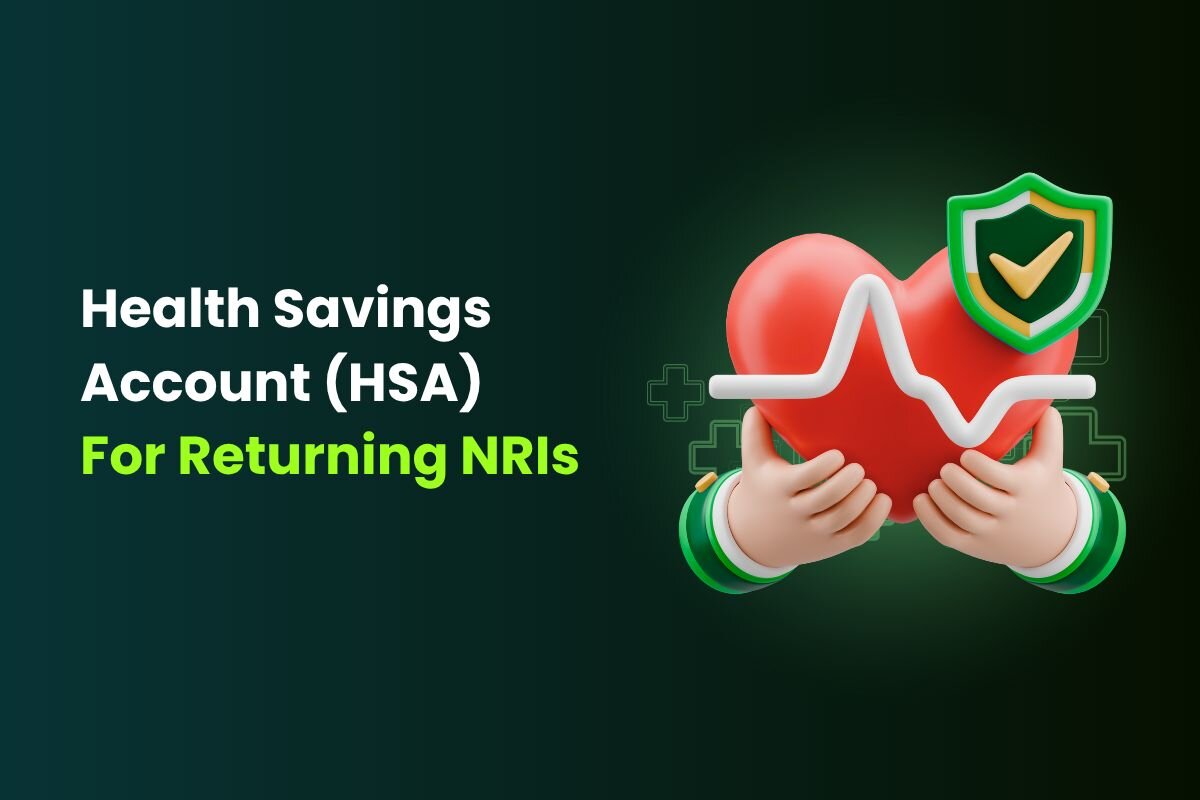The National Pension System (NPS) offers NRIs a smart way to plan for retirement, with returns ranging between 9% and 15% depending on market conditions and your chosen investment strategy. Managed by the Pension Fund Regulatory and Development Authority (PFRDA), this government-backed retirement savings scheme is open to Non-Resident Indians (NRIs), Overseas Citizens of India (OCIs), and Persons of Indian Origin (PIOs).
Starting at just ₹2,000 per month, NPS is an affordable option to secure your financial future. Additionally, it provides tax advantages, including deductions up to ₹1.5 lakh under Section 80CCD(1B), as well as an Exempt-Exempt-Exempt (EEE) tax status.
Key Takeaway
The National Pension System (NPS) offers NRIs an affordable and tax-efficient way to save for retirement with global accessibility. In this blog, you’ll learn how to open an NPS account, the tax benefits, and investment options available for NRIs.
- Open an NPS account online via the eNPS portal with a minimum ₹500 contribution
- Enjoy tax deductions up to ₹2 lakh on NPS contributions under Sections 80CCD(1) and 80CCD(1B)
- Choose between Active or Auto Choice investment strategies based on your risk preference
- Manage your NPS account globally via the eNPS portal or mobile app
- Repatriate NPS funds to NRE/NRO accounts, with tax exemptions and DTAA benefits
- Withdraw tax-free portions at age 60 and make partial withdrawals for emergencies
2. Why NRIs Should Consider NPS in 2025
The National Pension System (NPS) is one of the best retirement savings options for NRIs, offering significant benefits tailored to the unique needs of non-resident investors. As the global financial landscape evolves in 2025, here's why you should consider opening an NPS account if you’re an NRI:
2.1 Long-Term Retirement Planning in India
The NPS provides a disciplined and reliable way to save for retirement, leveraging diversified investments across multiple asset classes such as equity, corporate bonds, and government securities. This diversified approach ensures that your savings grow over time while protecting them against market volatility.
Equity (Scheme E): Historically, NPS equity investments have delivered annual returns of 12-15%, providing a strong growth engine for your retirement savings.
Government Bonds (Scheme G): Offering more stability, these bonds have returned 9-10% annually, making them a safe bet in uncertain market conditions.
Corporate Bonds (Scheme C): Corporate bonds yield 8-10% returns, offering a good middle ground between risk and reward.
By mixing these asset classes, NPS provides a balanced approach to long-term growth. Equity investments tend to have higher returns but come with increased volatility, while government bonds and corporate bonds offer more stability but lower returns. This asset allocation helps you manage risk and increase your savings over time, ensuring that your money grows steadily and outpaces inflation.
2.2 Low-Cost, Government-Backed Scheme
NPS stands out not only for its investment potential but also for its affordability. The fund management fees are exceptionally low, ranging from 0.01% to 0.1% annually. This makes NPS one of the most cost-effective retirement plans available, especially compared to other investment options like mutual funds or private pension plans.
Additionally, starting with NPS is budget-friendly. The Tier I account, which is the mandatory retirement account, requires just ₹500 to open, with a minimum annual contribution of ₹1,000. This makes it accessible to NRIs from all income brackets.
NPS also operates under the PFRDA Act of 2013, with government oversight ensuring that the scheme remains secure and well-regulated.
2.3 Global Accessibility and Portability
One of the most significant advantages of NPS for NRIs is its portability. Whether you are living in the US, UAE, Singapore, or any other country, your NPS account remains active. This is ideal for mobile NRIs who move frequently or those who plan to eventually return to India.
- Permanent Retirement Account Number (PRAN): When you open an NPS account, you get a unique PRAN, which stays with you, even if you change countries.
- Easy Contributions: You can contribute to your NPS account from your NRE or NRO accounts, making the entire process seamless, no matter where you are.
If you decide to move back to India permanently, you can simply convert your NPS account from NRI status to resident status, without any additional paperwork or fees. This smooth transition makes NPS a highly flexible, long-term retirement solution for NRIs.
Furthermore, the eNPS portal and mobile app give you 24/7 access to your account. Whether you're in India or abroad, you can monitor your NPS account anytime and manage your investments efficiently. This global accessibility means you can stay connected to your Indian retirement savings even while living abroad.
2.4 Tax Advantages and Contributions
NPS offers compelling tax benefits that make it a highly attractive retirement option for NRIs. Contributions to NPS Tier I accounts are eligible for deductions under Section 80CCD(1B) of the Income Tax Act. You can claim:
- Up to ₹1.5 lakh in tax deductions for contributions to NPS under Section 80CCD(1).
- An additional ₹50,000 in tax deductions under Section 80CCD(1B), which is exclusive to NPS.
These tax benefits can significantly reduce your taxable income in India, providing immediate financial relief while helping you save for the future.
2.5 Active vs. Auto Choice Investment Strategies
NPS offers two investment strategies depending on how much control you want over your asset allocation:
- Active Choice: With Active Choice, you decide how much to invest in equity, corporate bonds, government securities, and alternative investments. You can allocate up to 75% of your funds into equity until you turn 50. After that, the equity allocation is gradually reduced by 2.5% each year. This strategy allows you to be more hands-on with your investments and is ideal if you’re familiar with market dynamics and want to optimize your returns.
- Auto Choice: For those who prefer a more hands-off approach, the Auto Choice strategy adjusts your asset allocation automatically based on your age. As you get older, the system shifts your investments towards more conservative options (e.g., government bonds and corporate bonds), ensuring a lower risk profile as you approach retirement.
3. Who Can Apply and What You Need
The National Pension System (NPS) offers NRIs a valuable opportunity to plan for retirement, but it’s essential to understand the eligibility criteria and the documents required to open an account. In this section, we’ll walk you through the application process and what you need to get started.
3.1 Eligibility Criteria for NRIs
To open an NPS account as an NRI, you must meet the following basic eligibility criteria:
- Indian citizenship: You must be an Indian citizen, whether you are a resident or non-resident.
- Age requirement: You must be between 18 and 70 years old at the time of application. This age range was extended from the earlier limit of 60 years, making NPS accessible to a wider range of investors, including those who want to start saving for retirement later in life.
- KYC compliance: You must fulfill the Know Your Customer (KYC) requirements, which we’ll cover in more detail in the next section.
It's worth noting that while NRIs are eligible for Tier I accounts, they typically cannot open a Tier II account. The Tier II account offers more flexibility in withdrawals but fewer tax benefits, and is generally only available to resident Indians.
3.2 Required Documents and KYC Norms
Opening your NPS account requires submitting a few key documents for identity and address verification. NRIs must comply with KYC norms to ensure the security of the system and verify your identity.
Here are the documents you will need to provide:
- Recent Passport-sized Photograph
- A clear passport-sized photograph is necessary for account registration.
- PAN Card (Mandatory)
- The Permanent Account Number (PAN) card is a mandatory document for all Indian citizens and NRIs. This is used to link your NPS account with your tax records.
- Indian Passport Copy
- You must provide a copy of your Indian passport as proof of your citizenship. This helps verify your identity as an NRI.
- Proof of Address
- Indian Address Proof (if applicable): If you have an Indian address, you’ll need to provide proof (e.g., utility bill, bank statement, etc.).
- Foreign Address Proof: As an NRI, you’ll also need to provide proof of your foreign address, such as a utility bill, bank statement, or lease agreement.
- Proof of NRE/NRO Bank Account
- A canceled cheque from your NRE (Non-Resident External) or NRO (Non-Resident Ordinary) account must be provided. This confirms your bank details and allows you to contribute to your NPS account through these accounts.
3.3 KYC Verification
KYC is an essential step before your NPS account can be activated. For NRIs, there are two ways to complete the KYC process:
- eKYC (Electronic KYC): NRIs can complete the KYC process electronically via the eNPS portal using their Aadhaar or PAN details. This method is the quickest and simplest.
- Physical Verification: After completing the online application, you must send the signed physical form (generated during the registration process) along with a photograph. This form must be mailed to the Central Recordkeeping Agency (CRA) within 90 days from the date of online registration.
Failure to submit the physical form within the given period may result in your account being frozen until the necessary documents are submitted.
3.4 Restrictions for OCIs and PIOs
Over the years, the rules for Overseas Citizens of India (OCI) and Persons of Indian Origin (PIO) have evolved. As of 2019, the Indian government has allowed OCIs to invest in the National Pension System (NPS), but with some restrictions:
- OCI Account Types: Like NRIs, OCIs can only open Tier I accounts in the NPS, which are meant for retirement savings. They are not allowed to open Tier II accounts, which offer more flexibility but fewer tax benefits.
- OCI Documentation: OCIs must provide their OCI card as part of the KYC process when opening their NPS account.
- Bank Account: OCIs must use their NRE or NRO accounts for NPS transactions, just like NRIs.
However, PIOs (Persons of Indian Origin) are not eligible to open NPS accounts. In addition, Hindu Undivided Families (HUFs) are also excluded from participating in the NPS scheme.
Note: You cannot use a Power of Attorney (PoA) to open an NPS account on someone’s behalf. The application and verification process must be completed by the individual investor themselves, though you can nominate someone to receive your funds upon death.
4. How to Open an NRI NPS Account
Opening an NPS account as an NRI is a simple and user-friendly process. Thanks to the eNPS portal, NRIs can complete the entire application online without having to visit any branch. The steps are straightforward, and you can begin planning your retirement fund from anywhere in the world.
Here’s a detailed breakdown of how to open your NPS account in just a few easy steps:
Step 1: Visit the eNPS Portal
To get started, go to the official eNPS website managed by the Pension Fund Regulatory and Development Authority (PFRDA). Look for the "New Registration" or "Registration" button on the homepage.
- Direct link: eNPS portal
- The portal is designed specifically for NRIs, making it simple to apply for an NPS account from anywhere globally.
Step 2: Choose Account Type and Fill Personal Details
Once you’ve accessed the eNPS portal, you’ll need to choose “Non-Resident Indian (NRI)” as your residential status. After that, you will be asked to choose between a "Repatriable" or "Non-Repatriable" account. The choice you make will depend on whether you want to be able to transfer your NPS funds abroad in the future.
- Repatriable Account: This account allows you to transfer both your principal and interest abroad (via your NRE account).
- Non-Repatriable Account: The funds in this account can be withdrawn in India, but you cannot transfer them abroad.
You’ll also need to fill in your personal details, including:
- Full name
- Date of birth
- Father’s name
- Contact information (email and mobile number)
- Communication address (Indian or foreign address)
Step 3: Upload Documents and Make Initial Contribution
Next, you will be required to upload documents to verify your identity. These documents include:
- Passport-sized photograph
- PAN Card
- Indian passport copy
- Proof of NRE/NRO bank account (e.g., canceled cheque)
After uploading the documents, you will need to make your first contribution to the NPS account. The minimum contribution for Tier I accounts is ₹500, which you can make using internet banking or a debit card linked to your NRE or NRO account.
Once your payment is processed, you will receive your Permanent Retirement Account Number (PRAN). This 12-digit number will be your unique identifier for all future NPS transactions.
Step 4: Send Signed Form to CRA
After completing the online registration and payment, the system will generate a signed form with your details. You need to print this form, sign it, and affix your photograph in the designated areas.
- Mail the signed form along with a self-attested copy of your documents (such as your passport, PAN card, etc.) to the Central Recordkeeping Agency (CRA).
- The physical form must be mailed to CRA within 90 days of registering online, or your account will be frozen.
- Make sure to keep a copy of the form for your records.
Once CRA verifies your documents, your NPS account will be fully activated, and you can begin managing your retirement fund.
Step 5: Access and Manage Your NPS Account
After the successful activation of your NPS account, you can manage it easily through the eNPS portal or mobile app. This platform allows you to:
- Track your contributions
- Check your balance
- Switch between investment options (Active or Auto Choice)
- Make additional contributions
Important Notes for NRIs
- Documents must be submitted within 90 days: If you fail to submit the signed form to CRA within the required timeframe, your account will be temporarily suspended.
- Keep your details updated: If your contact information or bank details change, make sure to update them in the eNPS portal to avoid any future issues with contributions or withdrawals.
- Minimum Contribution: The minimum contribution for Tier I accounts is ₹500, and ₹1,000 for a Tier II account, though Tier II accounts are not available for NRIs.
This step-by-step guide ensures that the process to open your NPS account is as smooth and hassle-free as possible.
By following these steps, you will be able to start saving for your retirement in India while benefiting from the low-cost, flexible, and tax-efficient features of NPS.
5. Understanding Investment and Returns
Once your NPS account is activated, the next step is to choose how your money is invested. NPS offers various investment options that suit different risk appetites and financial goals. The key to growing your retirement savings lies in choosing the right combination of assets, depending on how much risk you are willing to take and how long you plan to stay invested.
5.1 Tier I vs Tier II Accounts for NRIs
NRI investors can only open Tier I accounts under the NPS scheme. Tier I is designed for retirement planning and comes with a lock-in period until the age of 60. During this time, partial withdrawals are allowed only after 3 years for specific needs like education, marriage, or medical emergencies.
Unlike resident Indians, NRIs cannot open Tier II accounts, which offer more flexibility in withdrawals but do not provide the same tax benefits. Therefore, the focus for NRIs should be entirely on Tier I accounts, which are tax-efficient and structured for long-term retirement planning.
5.2 Active vs Auto Choice Investment Strategy
NPS provides two main investment options:
- Active Choice
- In this option, you are in control of your investment allocation. You can choose how to split your funds among different asset classes: Equity (E), Corporate Bonds (C), Government Securities (G), and Alternative Investments (A).
- You can allocate up to 75% of your funds in equity until you turn 50. After that, the percentage of equity exposure gradually decreases by 2.5% each year.
- This option is ideal for those who are familiar with market trends and want to actively manage their investments based on their risk tolerance.
- Auto Choice
- If you prefer a more hands-off approach, the Auto Choice option automatically adjusts your asset allocation as you age. The system becomes more conservative as you approach retirement age.
- The Auto Choice option offers three risk profiles:
- Conservative Lifecycle Fund (LC-25): Maximum 25% equity exposure
- Moderate Lifecycle Fund (LC-50): Maximum 50% equity exposure
- Aggressive Lifecycle Fund (LC-75): Maximum 75% equity exposure
- Auto Choice is designed for NRIs who want to save for retirement but prefer the system to handle investment allocation based on their age and risk tolerance.
5.3 Expected Returns from Different Asset Classes
Your returns in NPS will vary based on your investment strategy and market conditions. Here’s a breakdown of expected returns from different asset classes available in NPS:
- Equity (Scheme E):
- Historically, equity investments in NPS have provided annual returns of 12-15%. These returns tend to be volatile in the short term but can offer higher growth in the long term.
- Since equity investments come with higher risk, they tend to outperform other asset classes over time. However, the risk factor is significant in the short term, so this option is best suited for those with a longer investment horizon.
- Government Bonds (Scheme G):
- Government securities are considered a safe investment, providing stable returns of 9-10% annually. These are ideal for NRIs who are more risk-averse and prefer stable, lower-risk returns.
- These investments are backed by the Indian government, which offers strong protection during market volatility, but the returns are lower compared to equity.
- Corporate Bonds (Scheme C):
- Corporate bonds offer a balance between risk and return, with expected returns ranging from 8-10% annually. These investments provide higher returns than government bonds but come with more risk, as they are dependent on the financial health of the companies issuing the bonds.
- Alternative Investments (Scheme A):
- For NRIs who want to diversify further, NPS offers Alternative Investments (such as real estate and infrastructure). These tend to have higher returns but come with greater risks. However, the allocation to this scheme is generally smaller and may be included as a part of the diversified portfolio.
6. Taxation, Withdrawals, and Repatriation
The National Pension System (NPS) offers NRIs substantial tax benefits, flexible withdrawal options, and a smooth process for repatriating funds back to your country of residence. Understanding these features is crucial for maximizing the benefits of your NPS investment.
Let’s break down the important aspects related to taxation, withdrawals, and repatriation.
6.1 Tax Benefits for NRIs
NPS offers significant tax deductions that can help NRIs reduce their taxable income in India, making it an excellent option for tax planning. There are two key tax deductions available under the Income Tax Act, 1961:
- Section 80CCD(1):
- Under Section 80CCD(1), you can claim deductions on contributions to your NPS account, up to 10% of your salary (if you are salaried) or 20% of your gross income (if you are self-employed).
- The maximum deduction available is ₹1.5 lakh per financial year, subject to the income limits mentioned above.
- Section 80CCD(1B):
- In addition to Section 80CCD(1), you can claim an extra deduction of ₹50,000 under Section 80CCD(1B) specifically for NPS contributions.
- This deduction is over and above the ₹1.5 lakh limit of Section 80C, allowing you to claim a total of ₹2 lakh in tax deductions.
This combination of tax benefits makes NPS a highly attractive retirement vehicle for NRIs who have income taxable in India.
6.2 Withdrawals from NPS
NPS has specific rules regarding withdrawals, both at maturity and before retirement. These rules ensure that the funds are primarily used for retirement purposes, while still providing flexibility for certain emergencies.
Withdrawals at Maturity (After Age 60)
- 60% of the corpus can be withdrawn tax-free when you reach the age of 60.
- The remaining 40% must be invested in an annuity plan (a regular pension plan) that provides you with a monthly income.
- The income generated from the annuity is taxable as per the prevailing income tax rates.
Early Withdrawals (Before Age 60)
If you decide to exit the NPS before reaching 60 years of age, the following rules apply:
- You can withdraw 20% of your NPS corpus tax-free.
- The remaining 80% of your corpus must be used to purchase an annuity. The income from the annuity will be subject to income tax at normal rates.
- Small Accounts: If your total NPS corpus is less than ₹2.5 lakh, you can withdraw the entire amount without the requirement to buy an annuity.
Partial Withdrawals
- NPS also allows partial withdrawals after 3 years for specific purposes like education, marriage, buying a home, or medical emergencies.
- You can withdraw up to 25% of your contributions (not the total corpus) for these purposes, and these withdrawals are tax-free under Indian law.
6.3 Repatriation of Funds
One of the key benefits of NPS for NRIs is that it allows for the repatriation of funds once the corpus matures or when partial withdrawals are made. Here’s how repatriation works:
Repatriation to NRE/NRO Accounts
- Once your NPS account reaches maturity, you can transfer the funds to your NRE (Non-Resident External) or NRO (Non-Resident Ordinary) accounts.
- NRE Account: The money transferred to your NRE account can be repatriated without any limits. Both the principal and interest earned are freely transferable.
- NRO Account: If the funds are transferred to your NRO account, you can repatriate up to USD 1 million per financial year, subject to tax payment and completion of required forms.
Taxation on Repatriated Funds
- TDS on Withdrawal: India applies TDS (Tax Deducted at Source) on the amount withdrawn from NPS, particularly when it involves the sale of annuity or interest income.
- Double Taxation Avoidance Agreement (DTAA): India has signed DTAA with several countries, including the US, UK, UAE, and others, to prevent the double taxation of income. The provisions of DTAA can help NRIs reduce or eliminate taxes on repatriated funds.
Repatriation Process
- Form 15CA/15CB: To repatriate funds from your NRO account, you need to submit Form 15CA (a declaration of taxes paid) and Form 15CB (a certificate from a Chartered Accountant) to the Indian tax authorities.
- Tax Payment Proof: Before repatriation, you need to show proof that you have paid the taxes applicable on your NPS corpus (including the tax on the annuity, if applicable).
Conclusion
The National Pension System (NPS) offers NRIs a low-cost, government-backed retirement savings option with attractive returns, tax benefits, and global accessibility. With returns between 9-15%, NPS provides a solid foundation for your retirement savings, whether you’re in India or abroad.
Frequently Asked Questions
How can NRIs open an NPS account in 2025?
NRIs can open an NPS account by visiting the eNPS portal, selecting 'Non-Resident Indian (NRI)' status, choosing between repatriable or non-repatriable account types, filling in personal details, uploading required documents, and making an initial contribution. After online registration, a signed physical form must be sent to the Central Record-keeping Agency within 90 days.
What are the tax benefits for NRIs investing in NPS?
NRIs can claim tax deductions of up to ₹1.5 lakh under Section 80CCD(1) and an additional ₹50,000 under Section 80CCD(1B), potentially allowing a total tax deduction of ₹2 lakh per financial year. However, these benefits apply only to income taxable in India.
What investment options are available for NRIs in NPS?
NRIs can choose between Active Choice, where they determine their own asset allocation across equity, corporate bonds, government securities, and alternative investments, or Auto Choice, which follows a lifecycle-based approach with automatic asset allocation adjustments based on age.
What are the withdrawal rules for NPS accounts held by NRIs?
At 60 years of age, NRIs can withdraw up to 60% of their NPS corpus tax-free, with the remaining 40% invested in an annuity plan. For premature exits before 60, the tax-free withdrawal portion reduces to 20%. Partial withdrawals of up to 25% are allowed after three years for specific purposes.
How do NRIs repatriate funds from their NPS account?
After maturity, NPS proceeds are credited to the NRI's NRE or NRO account. Funds in NRE accounts can be fully repatriated without caps. For NRO accounts, repatriation is limited to USD 1 million per financial year, subject to tax payments and necessary documentation like Forms 15CA and 15CB.
About the Author

By Prakash
CEO & Founder of InvestMates
Prakash is the CEO & Founder of InvestMates, a digital wealth management platform built for the global Indian community. With leadership experience at Microsoft, HCL, and Accenture across multiple countries, he witnessed firsthand challenges of managing cross-border wealth. Drawing from his expertise in engineering, product management, and business leadership, Prakash founded InvestMates to democratize financial planning and make professional wealth management accessible, affordable, and transparent for every global Indian.




